Design and Experiment of the Buckwheat Hill-Drop Planter Hole Forming Device
Abstract
:1. Introduction
2. Materials and Methods
2.1. Design Requirements
2.2. Design and Analysis of Key Components of the Hole Forming Device
2.2.1. Determination of the Duckbill Upper Jaw Length
2.2.2. Pressure Plate Design
2.3. Co-Simulation Analysis of EDEM and RecurDyn
2.3.1. The Influence of Spring on Cavitation Hole Forming
2.3.2. Establishment of EDEM Simulation Model
2.3.3. RecurDyn Simulation Analysis Principle
2.3.4. Co-Simulation of EDEM and RecurDyn
2.4. Bench Test
2.5. Experiment on Rotation Speed and Seeding Qualified Rate of the Dibber Wheel
3. Results and Discussion
3.1. Co-Simulation Results of EDEM and RecurDyn
3.2. Results of the Bench Test
3.3. Experimental Results of Rotation Speed and Seeding Qualification Rate in the Dibber Wheel
4. Conclusions
- The structure of the hole forming device and the dimensions of its related components were determined. According to the hole distance of 170 ± 10 mm and the seed metering device radius of 210 mm, the duckbill upper jaw length was determined to be 65 mm, the duckbills number was 10, the pressure plate on the spring side length was 90 mm, the duckbill opening size was 8.79 mm, and the duckbill effective opening time was 0.1 s.
- Through EDEM and RecurDyn coupling simulation, the force range of the pressure plate was 95–102.6 N when the spring compression was 33.3 mm. When the rotation speed of the dibber wheel was 40 r/min, the contact time of a single duckbill with the soil was 0.2 s. Through calculation and theoretical analysis, the duckbill spring was selected, and the big end middle diameter of the spring was 36 mm, the small end middle diameter of the spring was 26 mm, the original length of the spring was 60 mm, and the wire diameter of the spring was 1.8 mm. Through bench tests of duckbill springs with wire diameters of 1.6 mm, 1.8 mm and 2.0 mm, the spring wire diameter of 1.8 mm was determined as the optimal test result.
- Through the single factor experiment of the dibber wheel rotation speed, it was concluded that when the designed dibber wheel rotated at 40–65 r/min, its seeding qualification rate was ≥85.3%, the void hole rate was 0, and the damage rate was less than 0.3%, which meted the industry standard DG/T007-2019 for seeders issued by the Ministry of Agriculture and Rural Affairs, PRC. The driving speed of the hill-drop planter is 3.98–6.12 km/h, which provides a speed reference for the field planting operations of the following planters.
Author Contributions
Funding
Conflicts of Interest
References
- Li, J.; Yang, P.; Yang, Q.; Gong, X.; Ma, H.; Dang, K.; Chen, G.; Gao, X.; Feng, B.L. Analysis of flavonoid metabolites in buckwheat leaves using UPLC-ESI-MS/MS. Molecules 2019, 24, 1310. [Google Scholar] [CrossRef] [Green Version]
- Nešović, M.; Gašić, U.; Tosti, T.; Horvacki, N.; Nedić, N.; Sredojević, M.; Blagojević, S.; Ignjatović, L.; Tešić, Ž. Distribution of polyphenolic and sugar compounds in different buckwheat plant parts. RSC Adv. 2021, 11, 25816–25829. [Google Scholar] [CrossRef]
- Zou, L.; Wu, D.; Ren, G.; Hu, Y.; Peng, L.; Zhao, J.; Garcia-Perez, P.; Carpena, M.; Prieto, M.A.; Cao, H.; et al. Bioactive compounds, health benefits, and industrial applications of Tartary buckwheat (Fagopyrum tataricum). Crit. Rev. Food 2021, 1–17. [Google Scholar] [CrossRef]
- Zhu, F. Chemical composition and health effects of Tartary buckwheat. Food Chem. 2016, 203, 231–245. [Google Scholar] [CrossRef]
- Suzuki, T.; Noda, T.; Morishita, T.; Ishiguro, K.; Otsuka, S.; Brunori, A. Present status and future perspectives of breeding for buckwheat quality. Breed. Sci. 2020, 70, 48–66. [Google Scholar] [CrossRef] [Green Version]
- Zhou, M.; Tang, Y.U.; Deng, X.; Ruan, C.; Kreft, I.; Tang, Y.; Wu, Y. Overview of buckwheat resources in the world. In Buckwheat Germplasm in the World; Zhou, M., Kreft, I., Suvorova, G., Tang, Y., Wu, Y., Eds.; Academic Press: London, UK, 2018; pp. 1–7. ISBN 978-0-12-811006-5. [Google Scholar]
- Jiang, Y.; Wang, X.; Zeng, Z.; Han, J.; Schiavon, M.; Tang, C.; Lu, G.; Lei, Y.; Li, J.; Hu, Y.; et al. Performance of common buckwheat (Fagopyrum esculentum M.) in response to row spacing under ridge and furrow cropping systems in a semiarid region of China. Arch. Agron. Soil Sci. 2018, 64, 1807–1817. [Google Scholar] [CrossRef]
- Karayel, D.; Wiesehoff, M.; Özmerzi, A.; Müller, J. Laboratory measurement of seed drill seed spacing and velocity of fall of seeds using high-speed camera system. Comput. Electron. Agric. 2006, 50, 89–96. [Google Scholar] [CrossRef]
- Fang, Y.; Zhang, X.; Yu, X.; Hou, H.; Wang, H.; Ma, Y. Effects of whole soil-plastic mulching with hole-sowing on soil temperature, moisture and yield of buckwheat in aridlands. Acta Agron. Sin. 2019, 45, 1070–1079. [Google Scholar]
- Sugirbay, A.M.; Zhao, J.; Nukeshev, S.O.; Chen, J. Determination of pin-roller parameters and evaluation of the uniformity of granular fertilizer application metering devices in precision farming. Comput. Electron. Agric. 2020, 179, 105835. [Google Scholar] [CrossRef]
- Wang, J.; Qi, X.; Xu, C.; Wang, Z.; Jiang, Y.; Tang, H. Design evaluation and performance analysis of the inside-filling air-assisted high-speed precision maize seed-metering device. Sustainability 2021, 13, 5483. [Google Scholar] [CrossRef]
- Xing, H.; Wang, Z.; Luo, X.; He, S.; Zang, Y. Mechanism modeling and experimental analysis of seed throwing with rice pneumatic seed metering device with adjustable seeding rate. Comput. Electron. Agric. 2020, 178, 105697. [Google Scholar] [CrossRef]
- Parish, R.L. An automated machine for removal of plastic mulch. T ASAE 1999, 42, 49–51. [Google Scholar] [CrossRef]
- Wright, F.S.; Porter, D.M. Conservational tillage and cultivar influence on peanut production. Peanut Sci. 1995, 22, 120–124. [Google Scholar] [CrossRef]
- Sahoo, P.K.; Srivastava, A.P. Development and performance evaluation of okra planter. J. Agric. Eng. 1970, 37, 15–25. [Google Scholar]
- Lei, X.; Liao, Y.; Liao, Q. Simulation of seed motion in seed feeding device with DEM-CFD coupling approach for rapeseed and wheat. Comput. Electron. Agric. 2016, 131, 29–39. [Google Scholar] [CrossRef]
- Ye, S.; Zheng, D.; Li, W.; Lu, Q.; Yang, Y.; Liu, Y.; Xu, B. Design and test of negative pressure chamber rotary buckwheat seed metering device. INMATEH-Agric. Eng. 2021, 64, 185–194. [Google Scholar]
- Hunt, D. A vegetable seeder that plants through plastic and paper mulch. Ill. Res. 1961, 3, 16. [Google Scholar]
- Wang, X.; Kang, J.; Ding, H.; Peng, Q.; Zhang, C.; Li, N. Design and Test of 2BM-4 Film Mulch Precision Planter for Quinoa. Trans. Chin. Soc. Agric. Mach. 2020, 51, 86–94. [Google Scholar]
- Gu, L.; Zhang, W.; Liu, M. The design and experiment of the forced opening mechanism on the peanut dibbler. J. Hunan Agric. Univ. (Nat. Sci.) China 2017, 43, 676–679. [Google Scholar]
- Adilet, S.; Zhao, J.; Sayakhat, N.; Chen, J.; Nikolay, Z.; Bu, L.; Sugirbayeva, Z.; Hu, G.; Marat, M.; Wang, Z. Calibration strategy to determine the interaction properties of fertilizer particles using two laboratory tests and DEM. Agriculture 2021, 11, 592. [Google Scholar] [CrossRef]
- Zha, X.; Zhang, G.; Han, Y.; Salem, A.E.; Fu, J.; Zhou, Y. Structural optimization and performance evaluation of blocking wheel-type screw fertilizer distributor. Agriculture 2021, 11, 248. [Google Scholar] [CrossRef]
- Ding, S.; Bai, L.; Yao, Y.; Yue, B.; Fu, Z.; Zheng, Z.; Huang, Y. Discrete element modelling (DEM) of fertilizer dual-banding with adjustable rates. Comput. Electron. Agric. 2018, 152, 32–39. [Google Scholar] [CrossRef]
- Gummer, A.; Sauer, B. Modeling planar slider-crank mechanisms with clearance joints in RecurDyn. Multibody Syst. Dyn. 2014, 31, 127–145. [Google Scholar] [CrossRef]
- Wu, B.; Zhang, X.; Niu, L.; Xiong, X.; Dong, Z.; Tang, J. Research on sieving performance of flip-flow screen using two-way particles-screen panels coupling strategy. IEEE Access 2019, 7, 124461–124473. [Google Scholar] [CrossRef]
- Jin, X.; Cheng, Q.; Zhao, B.; Ji, J.T.; Li, M.Y. Design and test of 2ZYM-2 potted vegetable seedlings transplanting machine. Int. J. Agric. Biol. Eng. 2020, 13, 101–110. [Google Scholar] [CrossRef]
- Liu, J.D.; Cao, W.B.; Tian, D.Y.; Tang, H.Y.; Zhao, H.Z. Kinematic analysis and experiment of planetary five-bar planting mechanism for zero-speed transplanting on mulch film. Int. J. Agric. Biol. Eng. 2016, 9, 84–91. [Google Scholar]
- Liu, J.; Gao, C.; Nie, Y.; Yang, B.; Ge, R.; Xu, Z. Numerical simulation of Fertilizer Shunt-Plate with uniformity based on EDEM software. Comput. Electron. Agric. 2020, 178, 105737. [Google Scholar] [CrossRef]
- Zhao, X.; Zheng, P.; He, L.; Tao, M. Cutting edge preparation using the discrete element software EDEM. J. Braz. Soc. Mech. Sci. 2020, 42, 163. [Google Scholar] [CrossRef]
- Wang, J.; Tang, H.; Wang, Q.; Zhou, W.; Yang, W.; Shen, H. Numerical simulation and experiment on seeding performance of pickup finger precision seed-metering device based on EDEM. Trans. CSAE 2015, 31, 43–50. [Google Scholar]
- Xu, B.; Zhang, Y.; Cui, Q.; Ye, S.; Zhao, F. Construction of a discrete element model of buckwheat seeds and calibration of parameters. INMATEH-Agric. Eng. 2021, 64, 175–184. [Google Scholar]
- Han, D.; Zhang, D.; Jing, H.; Yang, L.; Cui, T.; Ding, Y.; Wang, Z.; Wang, Y.; Zhang, T. DEM-CFD coupling simulation and optimization of an inside-filling air-blowing maize precision seed-metering device. Comput. Electron. Agric. 2018, 150, 426–438. [Google Scholar] [CrossRef]
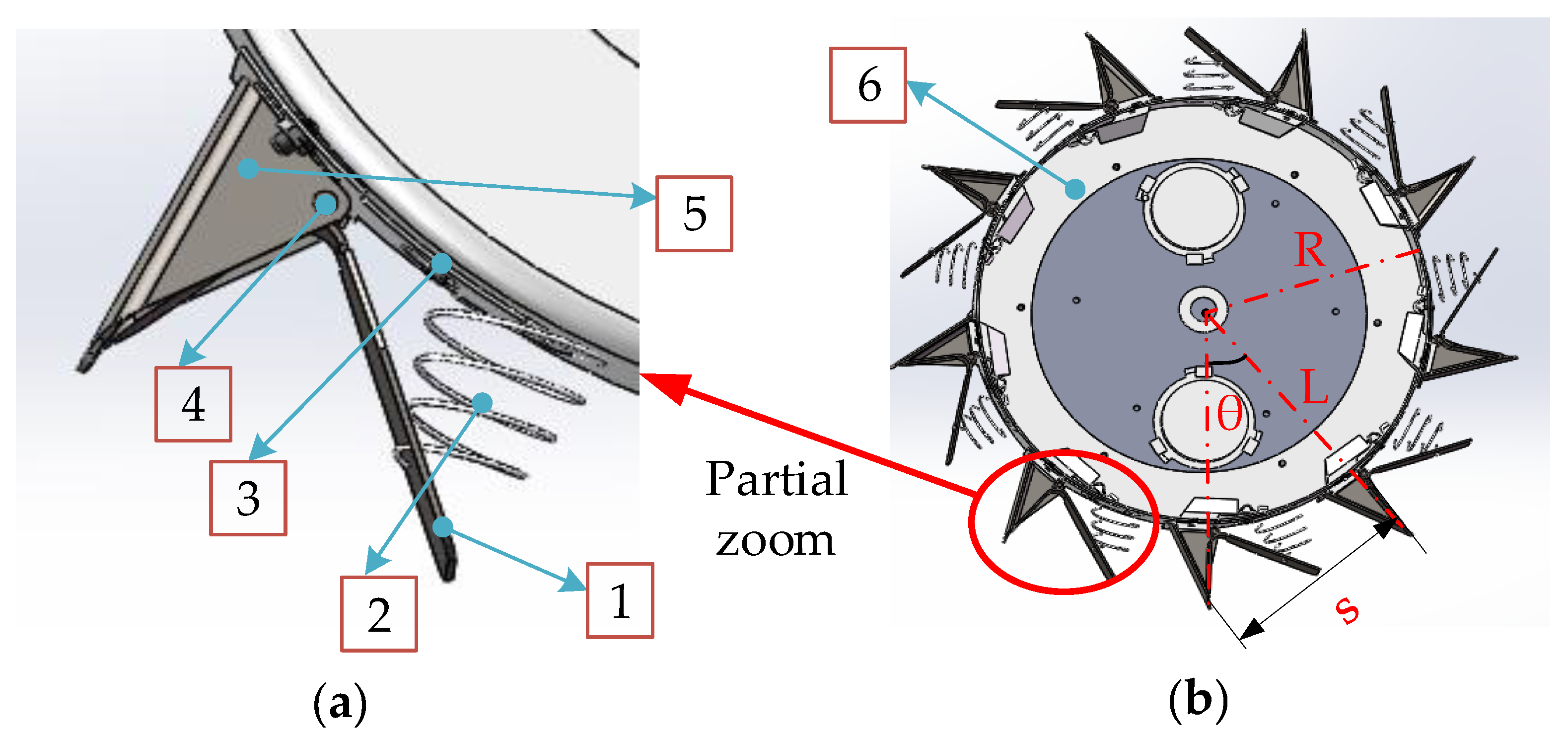
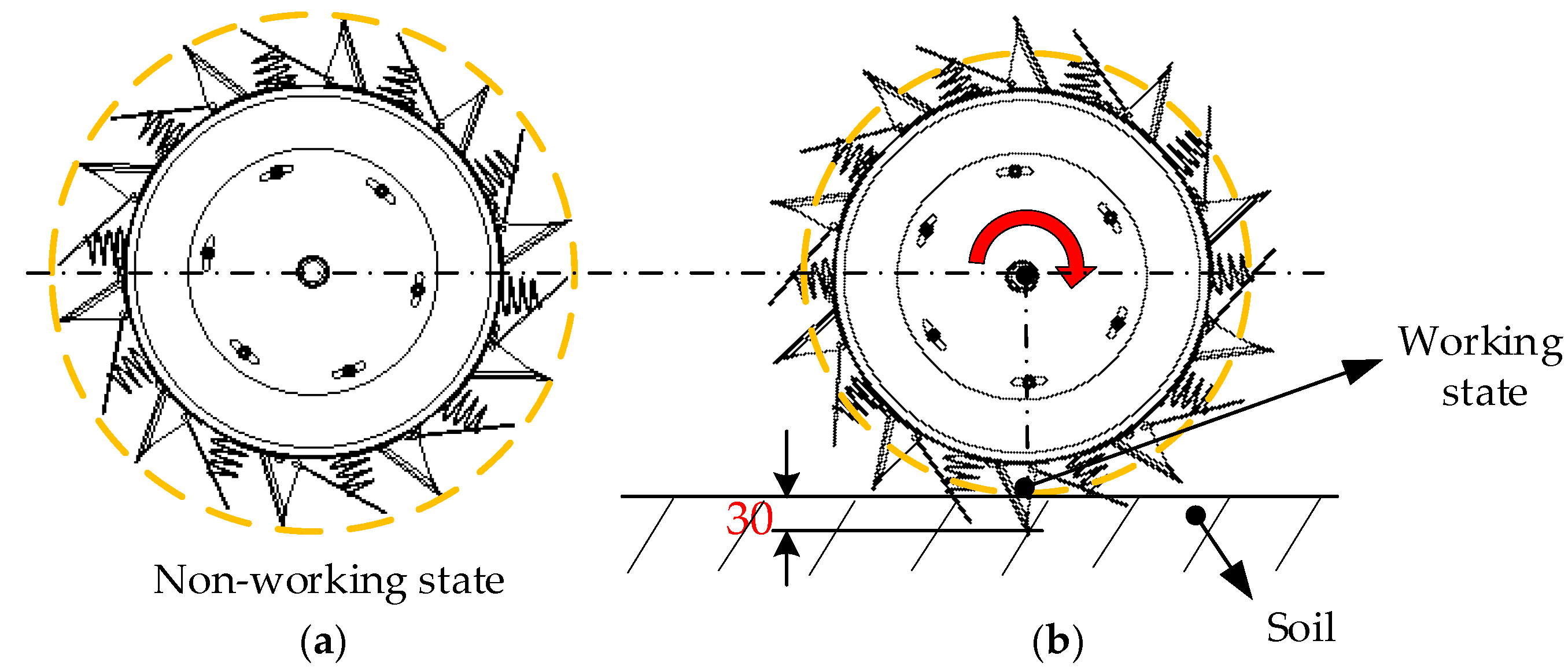


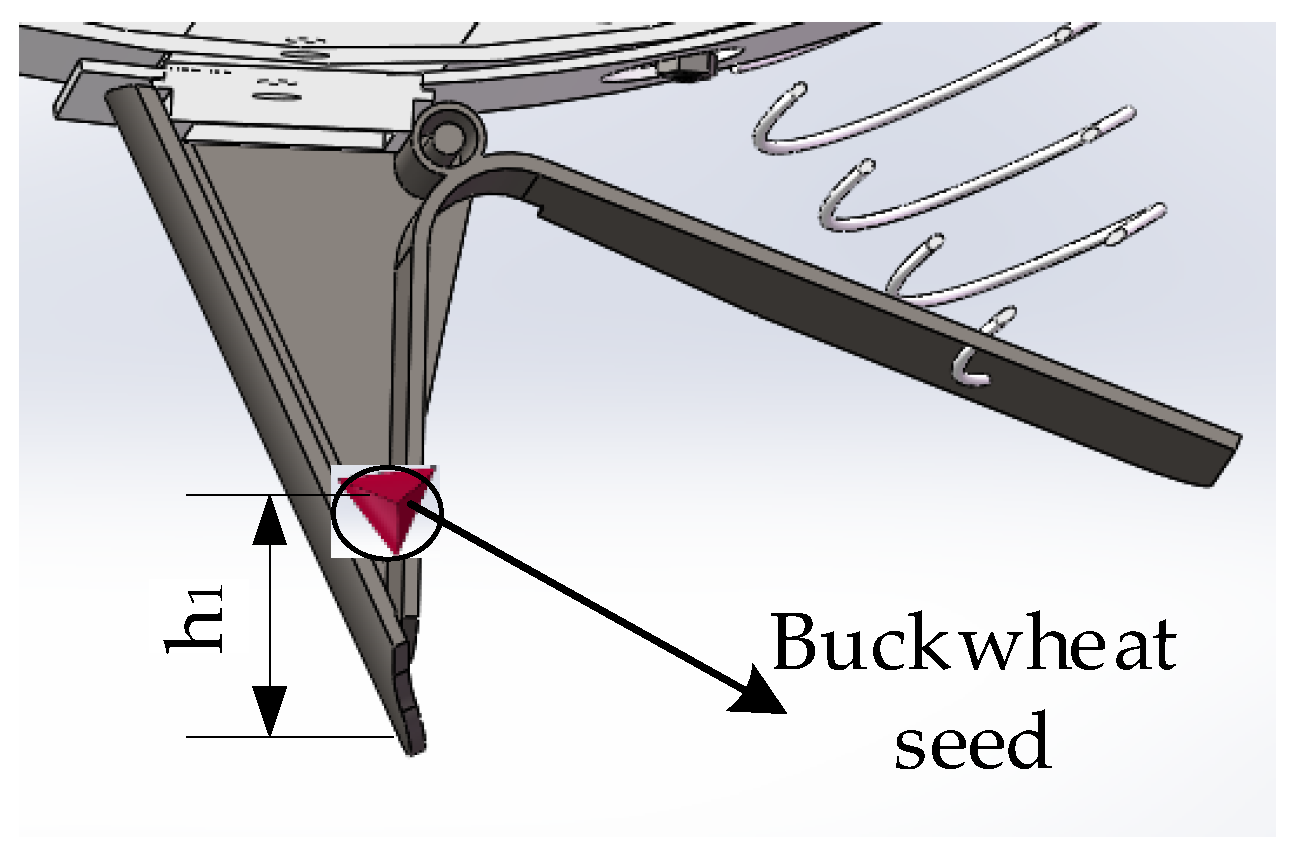
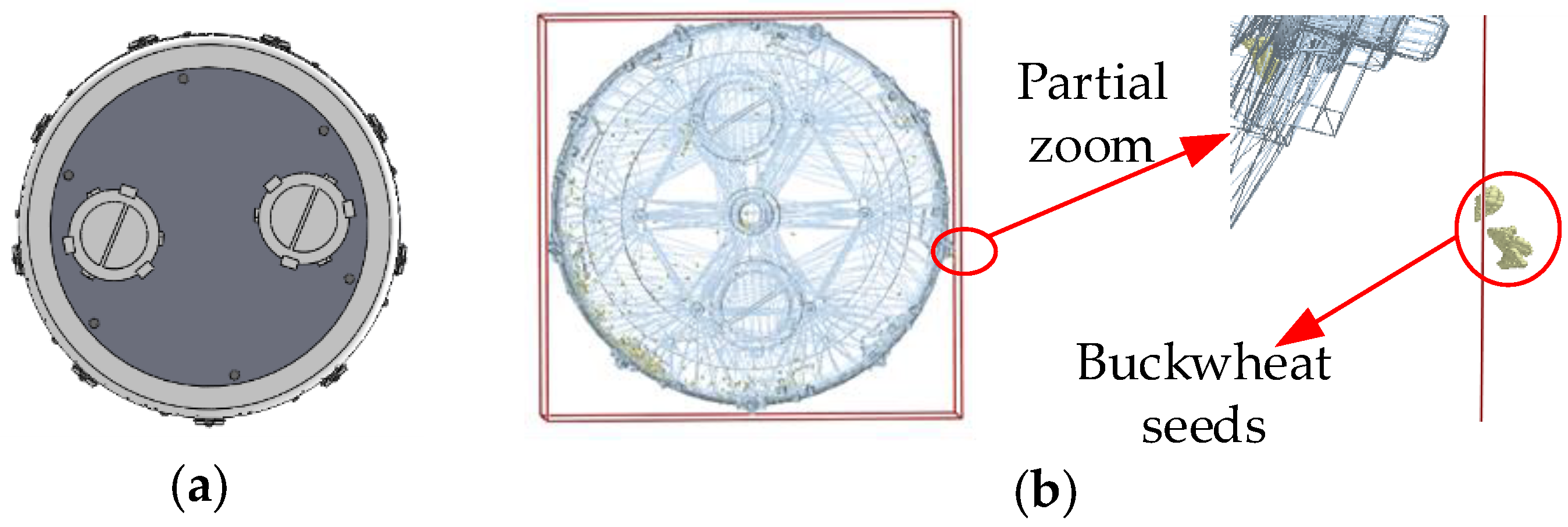





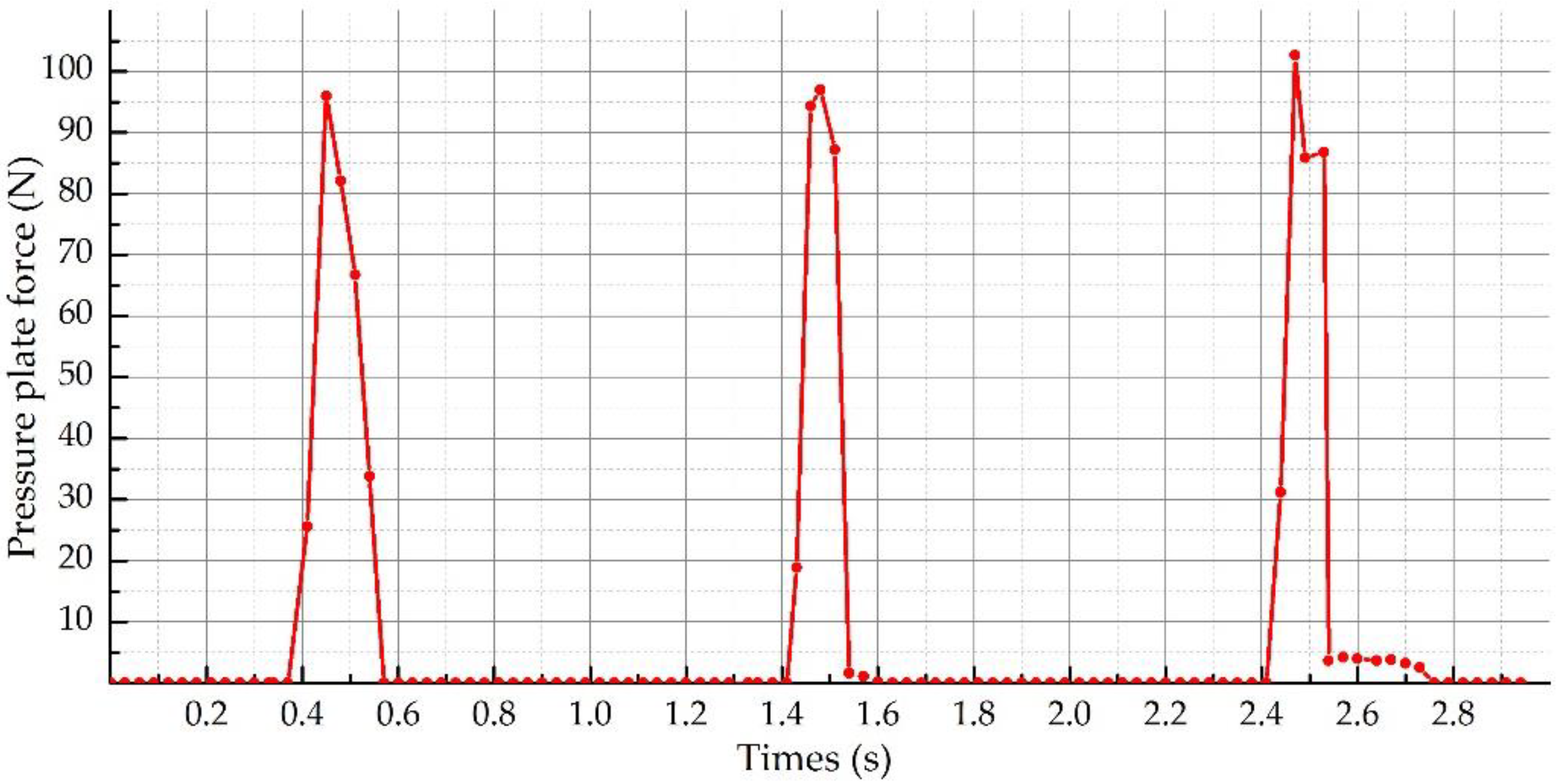
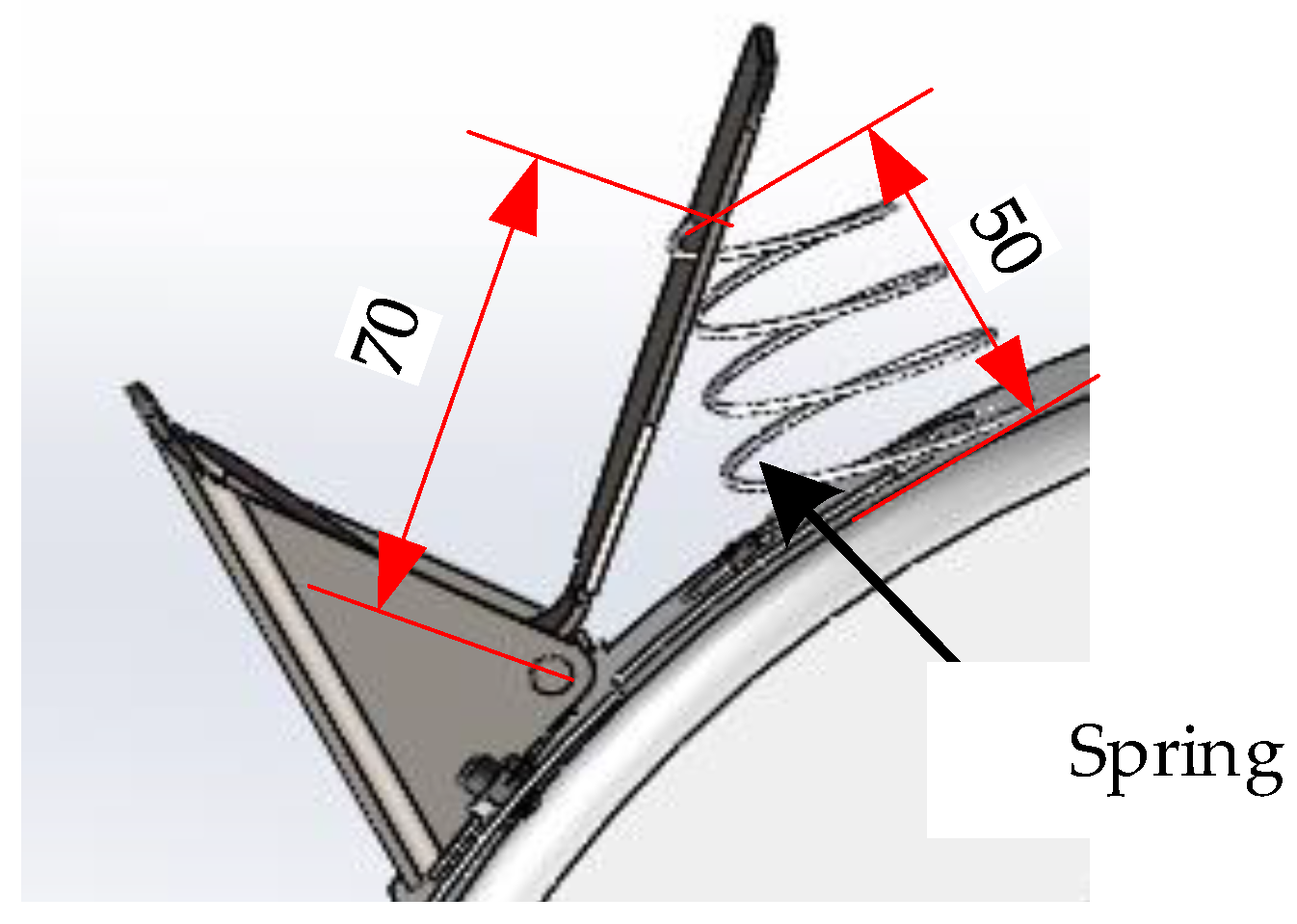
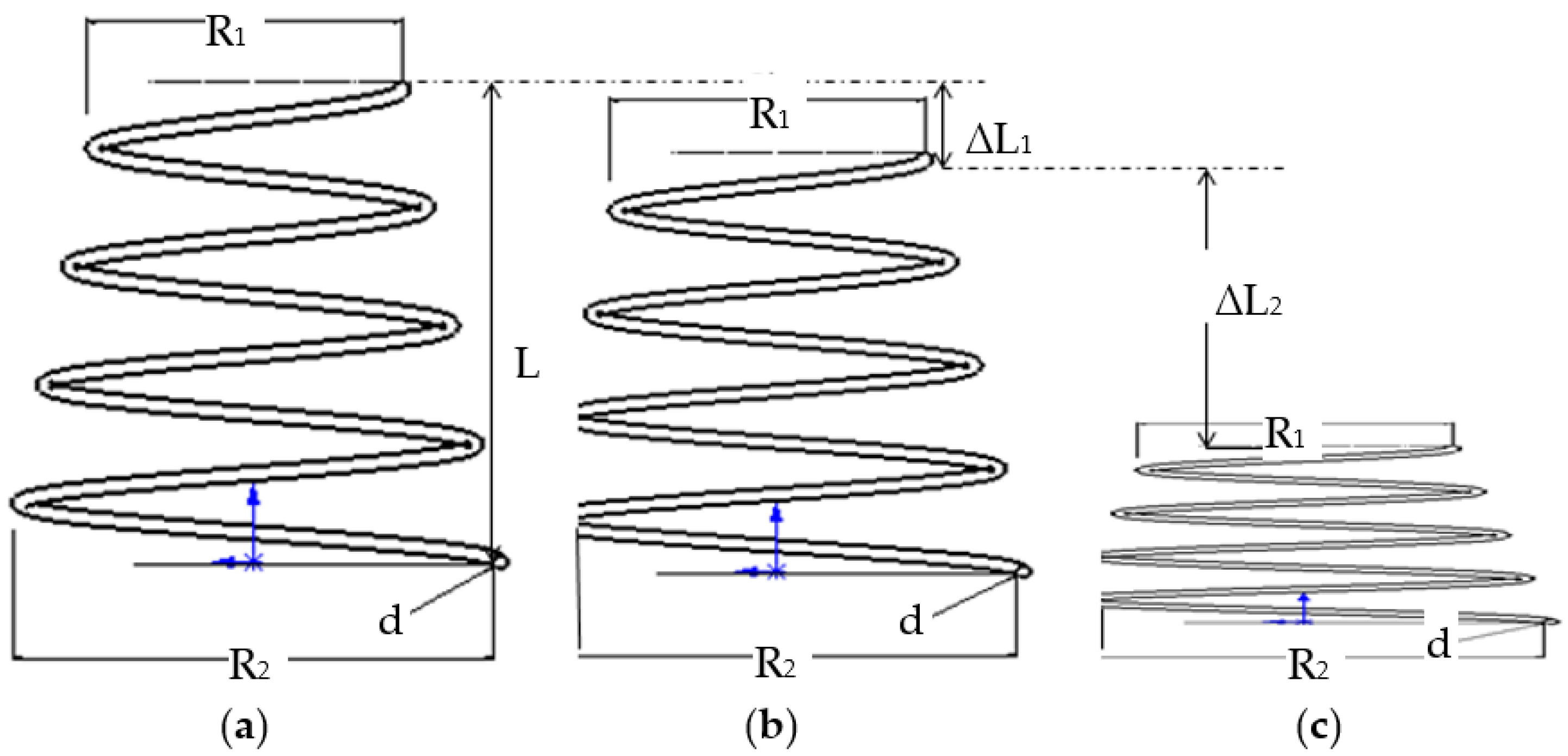

| Overall Dimensions (mm) | Seeding Row Number | Seeding Type | Operation Row Spacing (mm) | Hole Spacing (mm) | Seeding Depth (mm) | Seeds Number per Hole | Driving Speed (km/h) |
|---|---|---|---|---|---|---|---|
| L × W × H: 2000 × 2500 × 1500 | 4 | hole seeding | 380 ± 20 | 170 ± 10 | 20–40 | 3–5 | 4–6 |
| Parameter Types | Parameters | Values |
|---|---|---|
| Spring parameters | Stiffness coefficient (N/mm) | 1–3 |
| Damping coefficient | 0.035 | |
| Free length (mm) | 70 | |
| Spring diameter (mm) | 50 | |
| Coil number | 6 | |
| Wire diameter (mm) | 1.8 | |
| Contact parameters | Stiffness coefficient (N/mm) | 100 |
| Damping coefficient | 0.03 | |
| Dynamic friction coefficient | 0.01 | |
| Stiffness index | 2 | |
| Rebound damping coefficient | 0.25 | |
| Soil parameters | Relative density (kg/m3) | 1850 |
| Shear modulus (Pa) | 106 | |
| Poisson’s ratio | 0.38 | |
| Duckbill parameters | Density (kg/m3) | 7850 |
| Shear modulus (Pa) | 8.23 × 1010 | |
| Poisson’s ratio | 0.3 | |
| Interaction parameters | Soil–soil collision recovery coefficient | 0.66 |
| Soil–duckbill collision recovery coefficient | 0.51 | |
| Soil–soil static friction coefficient | 0.83 | |
| Soil–duckbill static friction coefficient | 0.5 | |
| Soil–soil dynamic friction coefficient | 0.25 | |
| Soil–duckbill dynamic friction coefficient | 0.05 | |
| Other parameters | Total number of particles | 100,000 |
| Acceleration of gravity (m/s2) | 9.81 | |
| Time step (s) | 3.14097 × 10−5 |
| Parameters | Test Number | Number of Test Samples (100 holes) | Average Qualification Rate (%) | ||
|---|---|---|---|---|---|
| The Spring Wire Diameter (mm) | Miss-Seeding Rate (%) | Repeat Seeding Rate (%) | Qualification Rate (%) | ||
| 1.6 | 1 | 4 | 7 | 89 | 89.33 |
| 1.6 | 2 | 4 | 6 | 90 | |
| 1.6 | 3 | 5 | 8 | 89 | |
| 1.8 | 4 | 3 | 6 | 91 | 91.67 |
| 1.8 | 5 | 4 | 5 | 91 | |
| 1.8 | 6 | 3 | 4 | 93 | |
| 2.0 | 7 | 5 | 6 | 89 | 88.00 |
| 2.0 | 8 | 6 | 8 | 86 | |
| 2.0 | 9 | 4 | 7 | 89 | |
| Test Number | Hole Distance/mm | |||||||||
|---|---|---|---|---|---|---|---|---|---|---|
| 1 | 2 | 3 | 4 | 5 | 6 | 7 | 8 | 9 | 10 | |
| 1 | 173.44 | 172.22 | 170.74 | 176.04 | 170.96 | 171.10 | 173.90 | 176.30 | 178.20 | 178.90 |
| 2 | 169.82 | 170.68 | 168.34 | 174.24 | 172.38 | 170.18 | 169.56 | 172.08 | 169.54 | 170.28 |
| 3 | 168.74 | 170.06 | 171.28 | 169.32 | 171.24 | 170.82 | 169.06 | 172.24 | 169.24 | 170.38 |
| 4 | 172.68 | 169.96 | 174.36 | 169.94 | 169.98 | 173.82 | 168.72 | 169.96 | 170.54 | 173.56 |
| 5 | 169.88 | 168.86 | 168.68 | 168.90 | 168.70 | 174.42 | 167.38 | 168.88 | 170.36 | 174.28 |
| 6 | 163.64 | 168.32 | 175.32 | 171.28 | 172.96 | 169.92 | 169.90 | 174.40 | 173.48 | 169.98 |
| 7 | 170.46 | 167.60 | 171.24 | 173.36 | 168.80 | 171.28 | 173.24 | 166.82 | 172.46 | 168.86 |
| 8 | 172.34 | 169.40 | 172.20 | 178.64 | 174.40 | 171.16 | 169.32 | 172.56 | 170.20 | 172.46 |
| 9 | 169.66 | 170.02 | 169.96 | 178.66 | 172.20 | 173.18 | 172.46 | 169.36 | 172.38 | 171.76 |
| The Spring Wire Diameter (mm) | Test Index | Rotational Speed of the Dibber Wheel (r/min) | Mean Value (mm) | Standard Deviation | Coefficient of Variation (%) | Qualification Rate (%) |
|---|---|---|---|---|---|---|
| 1.6 | Hole distance | 40 | 171.71 | 2.72 | 1.58 | 100% |
| 1.8 | 170.77 | 2.65 | 1.55 | 100% | ||
| 2.0 | 171.55 | 2.64 | 1.54 | 100% |
| Test Number | Parameters | Average Value of Three Repeated Tests | ||
|---|---|---|---|---|
| Rotational Speed of the Dibber Wheel (r/min) | Qualification Rate (%) | Void Hole Rate (%) | Damage Rate (%) | |
| 1 | 40 | 92.33 | 0 | 0.12 |
| 2 | 45 | 90.67 | 0 | 0.09 |
| 3 | 50 | 89.00 | 0 | 0.07 |
| 4 | 55 | 87.67 | 0 | 0.06 |
| 5 | 60 | 86.33 | 0 | 0.17 |
| 6 | 65 | 85.33 | 0 | 0.23 |
| 7 | 70 | 79.67 | 0 | 0.36 |
Publisher’s Note: MDPI stays neutral with regard to jurisdictional claims in published maps and institutional affiliations. |
© 2021 by the authors. Licensee MDPI, Basel, Switzerland. This article is an open access article distributed under the terms and conditions of the Creative Commons Attribution (CC BY) license (https://creativecommons.org/licenses/by/4.0/).
Share and Cite
Chen, Y.; Cheng, Y.; Chen, J.; Zheng, Z.; Hu, C.; Cao, J. Design and Experiment of the Buckwheat Hill-Drop Planter Hole Forming Device. Agriculture 2021, 11, 1085. https://doi.org/10.3390/agriculture11111085
Chen Y, Cheng Y, Chen J, Zheng Z, Hu C, Cao J. Design and Experiment of the Buckwheat Hill-Drop Planter Hole Forming Device. Agriculture. 2021; 11(11):1085. https://doi.org/10.3390/agriculture11111085
Chicago/Turabian StyleChen, Yu, Yuming Cheng, Jun Chen, Zhiqi Zheng, Chenwei Hu, and Jiayu Cao. 2021. "Design and Experiment of the Buckwheat Hill-Drop Planter Hole Forming Device" Agriculture 11, no. 11: 1085. https://doi.org/10.3390/agriculture11111085






